It’s no secret that we love social media. Everyone from your angsty, teenage cousin to your sweet, cookie-baking grandmother has a profile these days. From keeping up with friends and family to getting info about the latest news and trending topics, it seems that social can do it all.
In fact, users’ time spent on these social media platforms has increased considerably over the years – according to Broadband Search, we now devote about an additional hour per day to social media screen time compared to 2012. Currently, the average person spends about 153 minutes – about as long as it takes to watch two back-to-back movies – scrolling through social posts daily.

What’s more, new users are joining every day – each second that goes by sees another 11 people engaging with social media platforms for the very first time. This encompasses individuals of all age ranges – including people from your brand’s target audience to the CEO of your top competitor. By 2021, roughly half of the entire world’s population – about 3 billion people – will be active social media users. Right now, we’re at about 2.7 billion.
Social media can represent a powerhouse for your brand marketing, but it’s important that you’re able to offer your followers something new, and something worth engaging with. It certainly isn’t difficult to get stuck in a rut with your social media presence, particularly as some companies now post as often as 30 times a day, depending on the social platform.
Lookin’ at you, Twitter.
As you and your marketing team work to set up your next social media campaign, it’s helpful to switch things up a bit and try out some posts and strategies that your audience hasn’t seen from you before.
Social media campaign: What it takes to make it great
Some brands really have this whole social media marketing thing down. You see a post, and not only is it on brand and aligned with the company image, it’s interesting, engaging and provides users with something to do – be it taking a look at an interesting image, commenting in response to a question or offering up their own user-generated content for a contest.
There’s a nearly endless list of approaches you can take with your social media campaigns. But the best check off the following boxes:
- A theme or focus: These campaigns differ from regular social media posts, in that they include a theme or focus and are specifically targeted to the brand’s audience. We’re not just posting on social for the sake of posting on social – there’s a greater purpose involved.
- Measurable goals: Whether your company is looking to drive sales directly from social channels, encourage engagement with gated content to build email lists or drive traffic to the website, it’s important to create goals for your campaign that you can then measure and analyze.
- Savvy use of social media platforms: Each platform has its own unique look and feel, and therefore certain social sites may lend themselves better to a specific type of post, or for engaging with sections of the audience, than others. The veritable OG Facebook has been around since 2004 and, as such, can be more beneficial for reaching older market segments. Instagram, on the other hand, is ideal for images, and LinkedIn might be the brand’s best bet for publishing more professional blog content. Understanding the distinctions between social networks can help you post like a pro.
- Timing and frequency: This one might take a bit of market and audience research for you and your team, but it will pay off. Studies have proved that posting at certain times of the day will increase the chances of your audience seeing the content. At the same time, posting too often can be a turnoff for your followers – one HubSpot study found that pages with fewer than 10,000 followers saw less engagement per post when they posted more than once a day. In some cases, engagement dropped by 50% per post.
- Give something of value: Users’ newsfeeds are filled with news, trending topics ads, and all sorts of other content. The threat of them simply scrolling past your posts is very, very real. You need to give them a reason to stop and engage – this makes images, content and relevant CTAs key.
With these elements in place, your social campaign will help you:
- Connect with your target audience.
- Spur engagement.
- Boost brand awareness.
- Help breed loyalty with current clients, and convert potential customers.
7 social media campaign ideas:
1) Showcase your blog posts
2) Hash it out with a hashtag campaign
3) Put out the call for user-generated content
4) Turn up the heat with a contest or giveaway
5) Show off what you do best
6) Bring in an influencer
7) Make it memorable with a meme
Social media campaign ideas and examples
Now, for the good part. Let’s take a look at a few approaches and strategies you can consider for your next social campaign.
1) Showcase your blog posts
This tried-and-true social campaign strategy is a winner for several reasons. Chances are good that you’ve already created blog posts and content to go along with your campaign. Depending on the purpose or goal of your campaign, these could be in-depth blog posts on a particular subject or a press release making an important announcement. Whatever the case, you can repurpose these blog posts for your social campaign posts.
(We do it all the time here at Brafton.)
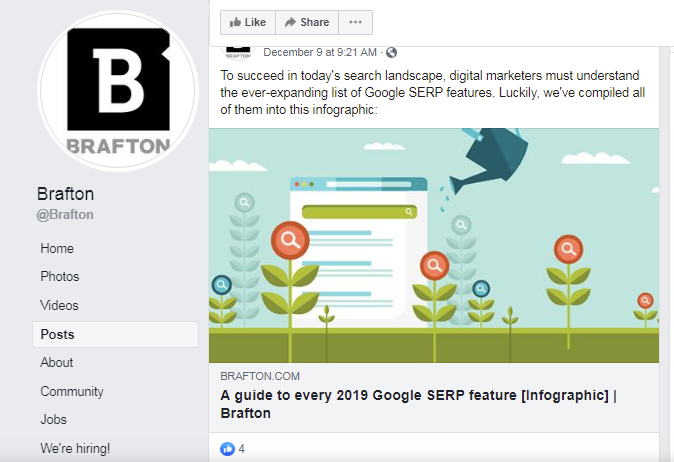
You can read more about repurposing content for social here.
Social management firm Buffer provides a great real-world example of how blog posts can represent the heart and soul of a social media marketing campaign. With strategies like guest blogging and the creation of highly shareable content, the company established four different blogs for various types of content. In addition to supporting this content with email marketing, Buffer regularly showcases these posts across its social channels.
Instagram Stories was one of the most dynamic social media channels in 2019.
We take a look at the best of the year: https://t.co/x7utLtuAh1
— Buffer (@buffer) December 14, 2019
Through this expert social media presence, Buffer was able to attract its first 100,000 customers, and now has more than 400,000 active users, alongside its 1 million+ followers on social.
2) Hash it out with a hashtag campaign
Social media campaigns can greatly benefit from a hashtag. Be it a branded hashtag that specifically aligns with your brand, or getting in on a trending hashtag that supports the purpose/goal of the campaign, these handy little handles can take your posts further than you ever thought possible. A unique and catchy hashtag can spur engagement and increase sharing, helping you to reach your current target audience, potential customers and even those outside your immediate customer market.
There are a few ways to go about tackling a hashtag campaign. You can get in on an already trending topic – #tbt (or #throwbackthursday for those living under rocks), is a great example of a hashtag that really took off. While this one’s a few years old, it’s still garnering engagement for brands like Charmin.
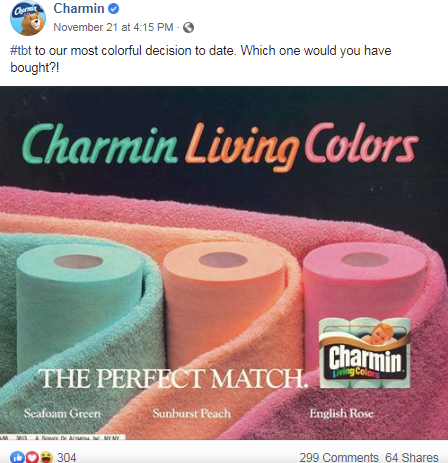
I honestly didn’t know that colored toilet paper was thing, but now I really want a roll.
Another strategy here is to use a branded hashtag that not only encourages engagement, but includes a connection back to the brand.
Speaking of the T.P. brand, Charmin’s been dubbed the “sassiest brand on Twitter” and their hilarious use of hashtags certainly helps them uphold the title. The company’s #tweetfromtheseat campaign was witty, on-brand and, let’s be honest, realistic – can you really say that you’ve never scrolled through social while in the bathroom?
We can't wait for the first #tweetfromtheseat in #280characters. For those days when you skipped your coffee and need the extra time.
— Charmin (@Charmin) September 27, 2017
If you need more examples of hashtag campaigns done right, look no further than your favorite late night talk show host. Almost every one of these personalities has pulled off a highly successful hashtag campaign, from Jimmy Kimmel’s #MeanTweets, to the king of trending hashtags, Jimmy Fallon.
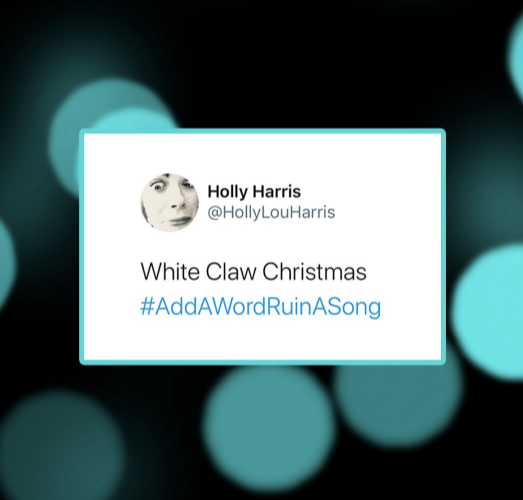
Fallon’s holiday themed hashtag, #AddAWordRuinASong, had me laughing all morning.
3) Put out the call for user-generated content
You can also put your campaign content in the hands of users with strategy hinging on user-generated content. It’s just what it sounds like, but requires an engaging and noteworthy call to action on your part in order to pull off. Users won’t participate for just any reason – you need a hook, or a prize (which we’ll talk about more in our next section below) to garner their interest.
Similar to hashtag campaigns, there are a few ways to leverage user-generated content, and it’s helpful to pick the approach that best aligns with the purpose and theme of your campaign. Consider approaches like:
- Highlighting user reviews: Glossier shows us this successful social media approach by regularly spotlighting and sharing reviews. Not only does this turn the attention from the brand to real customers, but it also cuts down on the need for content creation.
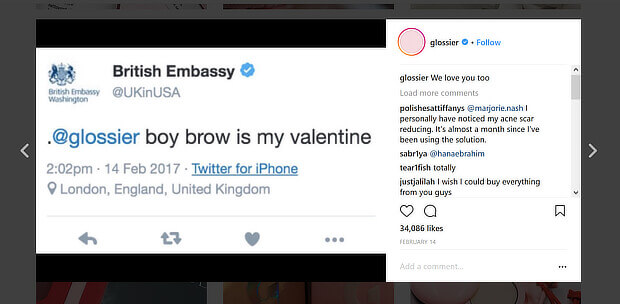
Another one of my favorites here is Treat Beauty. The makers of giant lip balm regularly showcase user reviews, photos and videos, which has helped the young brand create a consistent buzz on social. Here, they include user-generated content to entice customers into participating in their giveaway.
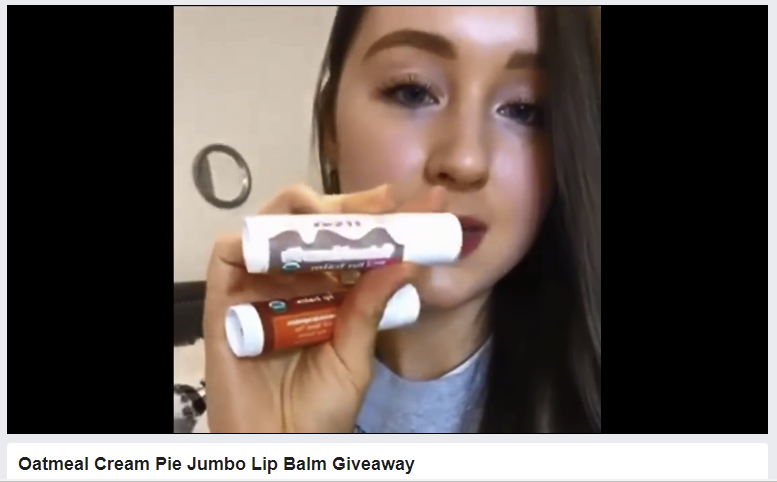
- Call for unique content: You can also ask users to create their own new content just for the purpose of the campaign, which your brand will then share across its social media platforms. This is the approach that Adobe took with its Art Maker Series and Beauty In Chaos campaigns.
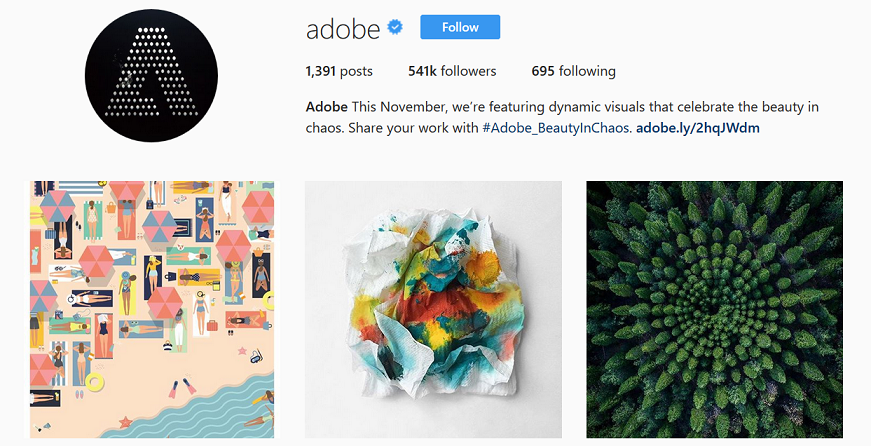
Never knew a dirty paper towel could be so picturesque.
We’re also digging this #ourArticle campaign from furniture company Article. While traditional showrooms and manufacturer images can feel staged and stuffy, being able to see how a piece looks in someone’s real living room, for instance, can be just what a shopper needs to convert.
A key advantage with UGC is the fact that many users (including members of your target audience) appreciate seeing this content, and trust it even more than posts coming directly from your brand. As WeDevs pointed out, 60% of users say they trust comments and photos from other customers more than those posted by the provider or manufacturer. Another 85% noted that they’re simply more influenced by content from other peer users than content from the company.
This pretty much says it all – if you aren’t including UGC in your campaigns, you’re missing out on a huge opportunity to cement trust with your followers and target audience.
4) Turn up the heat with a contest or giveaway
Spur a competitive spirit among your followers and get them engaged with a contest. We’ll go over a few approaches, but the best contests offer a prize or some type of reward for users’ engagement. Consider something that lines up with your brand and your current campaign – if you’re announcing a new product launch, for instance, you can host a contest and award the winner a first look at the new item you’re showcasing.
There are all kinds of contests out there, but some of our favorites include:
- Like and comment, or share to win: These are simple in premise, but provide a considerable payoff. Ask followers to like and comment on your post, or share it with their followers by a certain date, and then pick a winner.
- Tag a friend: These are fantastic for boosting brand awareness among your current target audience, as well as the potential customers who might be hiding in your audience’s networks. You can ask followers to tag a friend on a relatable post, or tag a friend they’d share your brand’s products/services with.
- Caption contest: Pick an interesting image and ask users to caption it. You can offer up a prize, or simply feature the winning caption on the brand’s social channels.
- Milestone giveaway: With this strategy, brands offer up a gift for meeting a certain milestone or goal. Home decor queen and Snoop’s bestie Martha Stewart has even gotten in on this trend.
If you are my 2 millionth follower – I will give you an amazing Singer sewing machine! Spread the word and RT
— Martha Stewart (@MarthaStewart) February 2, 2010
5) Show off what you do best
You can also build a successful social campaign by leveraging your brand’s particular expertise and creating something useful that few other companies are in the position to put out. Use your own internal or market data to highlight the trends in your industry, as Shutterstock has done the past few years with its Creative Trends report.
The asset is incredibly visual, shareable and interactive, covering a range of current pop culture trends, forecasts for future trending designs and emerging concepts. Sections even include images, videos or music, providing Shutterstock with snippets of shareable content for months to come.
The company also puts out an annual Color Trends report, with color palettes and visuals that just beg to be shared over social.
6) Bring in an influencer
Remember when we mentioned that users trust content from other users more than content posted directly by the brand? Another way to capitalize on this is with influencer marketing. Think of influencers as really fancy regular users, but with a much further reach. These individuals aren’t quite brand representatives, but a nod or recommendation from the right influencer – especially one with particularly high clout in your industry – can make a huge difference.
It’s important to be picky here, though. You wouldn’t choose just any celebrity to be your brand spokesperson, and the same thought and consideration should be taken when you partner up with an influencer. You need to find someone who has a connection with your target audience, and will help boost brand awareness by introducing their followers to your products/services. You can check out more thoughts on influencer marketing from the experts – including the pros and cons of this approach – here in this article.
While there are countless examples of influencer marketing campaigns going right, one of my favorites involves actor and comedian Nick Offerman. I know, I know, he’s more of a straight-up celeb than an “influencer,” but bear with me here.
Parks and Rec fans understand why this partnership is pretty perfect.
Offerman teamed up with Diageo, the company behind whiskey brands like Lagavulin, for a viral Yule Log video as part of the brand’s “My Tales of Whiskey” campaign.
Offerman does little more than sit next to a crackling fire, sipping a whiskey neat for a solid 44 mins – but that’s all it took. (Guys, he doesn’t even get up for a refill. I checked.)
The fam and I watch and sip along during the holidays.
The video was a huge hit across social, and a great example of pulling in an influencer that aligns with the brand image – it was so successful, the campaign even garnered Diageo an award.
7) Make it memorable with a meme
Memes have exploded in popularity thanks to their relatable, “everyone’s in on the same joke” appeal. These captioned images can also work wonders for your social campaigns, but as with influencer advertising, you need to make sure that you make the right choice for your current campaign.
A fun example comes to us from Jimmy Johns:
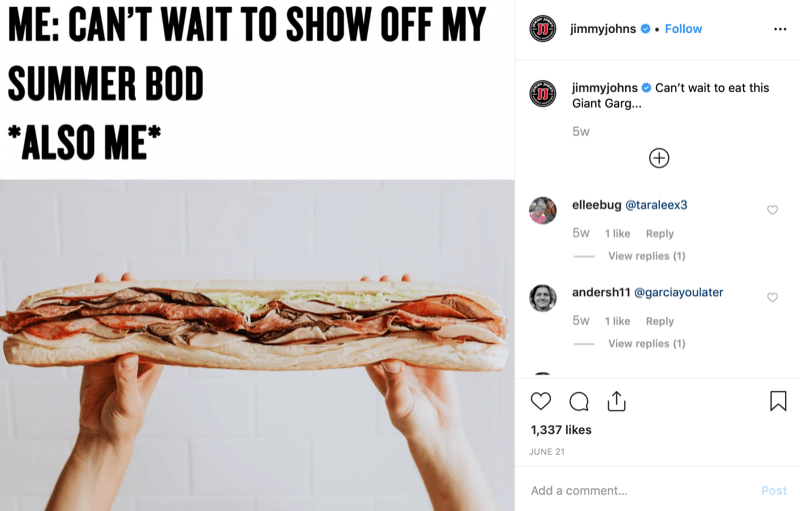
I would also sacrifice my summer bod for a sandwich of that caliber.
But one of my favorites is Charmin’s flawless use of the Meryl Streep meme:
In today’s social landscape, memes have the ability to take on a life of their own (I mean, you can actually buy an ugly sweater of the cat from that one meme – you know which one I’m talking about.) Using these as part of your social campaign strategy is a smart move, so long as it makes sense for your campaign and aligns with your brand image.
Make your next campaign engaging and shareworthy by trying out one (or a few!) of these unique ideas. Track how things are going, and apply these insights to your next campaign. Spicing things up with posts and content that your followers haven’t seen from you before could be just what you need to expand your reach, boost brand awareness and make a connection with your followers.





